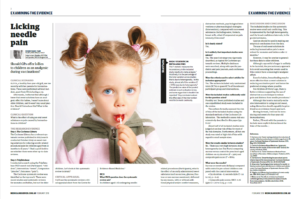Journal reference: Harrison D, Yamada J, Adams-Webber T, Ohlsson A, Beyene J, Stevens B. Sweet tasting solutions for reduction of needle-related procedural pain in children aged one to 16 years. Cochrane database of systematic reviews 2015 May 5(5):CD008408
Link: http://dx.doi.org/10.1002/14651858.CD008408.pub3
Published: May 2015
 Evidence cookie says… |
The effect of oral sweets on injection pain in children is unclear
|
 The article was originally published in the February 2018 issue of Medical Observer, under the title “Licking needle pain”. (PDF)
The article was originally published in the February 2018 issue of Medical Observer, under the title “Licking needle pain”. (PDF)
Clinical scenario
Olivia, a healthy 4-year-old girl, saw me recently with her parents for immunisations. These were performed without incident, apart from Olivia having a cry. Afterwards, I reflected that although I knew that sweet solutions had an analgesic effect for babies, I wasn’t sure about older children, and it wasn’t my usual practice. Should I introduce this? What is the evidence?
Clinical question
What is the effect of using an oral sweet substance on pain from immunisations in children?
What does the research evidence say?
Step 1: The Cochrane Library
The Cochrane Library has a relevant systematic review published in 2015 (search conducted October 2014) on sweet tasting solutions for reducing needle-related procedural pain for children aged 1 to 16 years [1]. I had a quick look to see whether there were other up-to-date reviews.
Step 2: TripDatabase
I conducted a search using the TripDatabase PICO search tool (Participant: “children”, Intervention: “sweet”, Comparator: “placebo”, Outcomes: “pain”). The Cochrane systematic review was identified as the top result. There were recent studies and systematic reviews for neonates and babies, but not for older children. Let’s look at this systematic review in detail [1].
Critical appraisal
I will use the systematic reviews critical appraisal sheet from the Centre for Evidence Based Medicine [2].
What PICO question does the systematic review ask?
In children aged 1 to 16 years undergoing needle-related procedures (Participants); what is the effect of an orally administered sweet tasting substance (e.g., sucrose, glucose, fructose, and non-sucrose sweeteners), delivered by any means, with or without additional physical and/or comfort measures, distraction methods, psychological interventions, or pharmacological strategies; (Intervention); compared to non-sweet substances (including water, formula, breast milk, other) (Comparator); on pain intensity (Outcome).
Is it clearly stated?
Yes.
Is it unlikely that important studies were missed?
Yes. The search strategy was rigorously described, as typical for Cochrane systematic reviews. Multiple databases were searched, specific paediatric and pain journals, and conference proceedings.
Were the criteria used to select articles for inclusion appropriate?
Yes. The authors only included randomised trials (RCTs) or quasi-RCTs of the relevant participant group and interventions.
Were the included studies sufficiently valid for the question asked?
Possibly not. A total of 7 published, and 1 unpublished study was included in the review. The authors formally assessed the risk of bias of the included studies using the standard methods of the Cochrane Collaboration. The method to assess risk was extensively described in this paper (pp. 8-10) [1]. About half of all included studies were judged at unclear risk of bias for most of the risk domains. Furthermore, all but one study was rated at high risk of bias with regards to small samples sizes.
Were the results similar between studies?
No. There was very high between-study heterogeneity (see Stat Facts) comparing sucrose versus control for pre-school aged children on cry duration (I2 = 94%), and composite pain score (I2 = 86%).
What were the results?
Sucrose or sweet taste (lollypop) compared to control in pre-school children compared with the control intervention:
- Cry duration: -15 seconds (95% CI -54 to 24), p = 0.45
- Composite pain scores: SMD -0.26 (95% CI -1.27 to 0.75), p = 0.61
Discussion and conclusion
The included studies in this systematic review were small and conflicting. This is represented by the very high heterogeneity, and the very broad confidence intervals in the pooled estimates. Caution should be used in making any empirical conclusions from the data.
The use of oral sweet solutions in reducing immunisation pain is more robust for neonates and babies under 12 months [3]. However, it may be unwise to generalise these data to older children. Although a spoonful of sugar is unlikely to be harmful, the precautionary approach is to avoid assuming that sweets used in this context have a meaningful analgesic effect. Even for babies, breastfeeding may be more effective than a sweet solution in reducing vaccination pain [4] and hence the preferred strategy where possible.
For children of Olivia’s age, there is better evidence supporting the use of distraction as a technique to reduce pain and distress from needle procedures [5]. Although this is not a mutually exclusive intervention to using an oral sweet, using distraction should arguably be prioritised as an evidence-based approach.
Moving forward, I will not be introducing oral sweets at 4-year-old immunisations. Rather, I’ll work with the parents to include more explicit distraction at the time of needle.
Stat Facts
High I2-statistic in meta-analyses
The I2-statistic measures the inconsistency in the included study results of a meta-analysis [6]. Intuitively, it is the percentage of the total variation across studies that is due to heterogeneity. In this study, almost all of the variation (I2 = 94%) was due to heterogeneity [1]. The predictive value of the pooled estimate is such a situation is low, and some argue that it shouldn’t be reported [7]. Any conclusions about the effect size of the intervention need to be made cautiously.
References
- Harrison D, Yamada J, Adams-Webber T, Ohlsson A, Beyene J, Stevens B. Sweet tasting solutions for reduction of needle-related procedural pain in children aged one to 16 years. Cochrane database of systematic reviews 2015 May 5(5):CD008408.
- Centre for Evidence Based Medicine. Systematic Review: Are the results of the review valid? Oxford: University of Oxford, 2005.
- Harrison D, Larocque C, Bueno M, et al. Sweet Solutions to Reduce Procedural Pain in Neonates: A Meta-analysis. Pediatrics 2017 Jan;139(1).
- Harrison D, Reszel J, Bueno M, et al. Breastfeeding for procedural pain in infants beyond the neonatal period. Cochrane database of systematic reviews 2016 Oct 28;10:CD011248.
- Uman LS, Birnie KA, Noel M, et al. Psychological interventions for needle-related procedural pain and distress in children and adolescents. Cochrane database of systematic reviews 2013 Oct 10(10):CD005179.
- Higgins JP, Thompson SG, Deeks JJ, Altman DG. Measuring inconsistency in meta-analyses. Bmj 2003 Sep 6;327(7414):557-60.
- Melsen WG, Bootsma MC, Rovers MM, Bonten MJ. The effects of clinical and statistical heterogeneity on the predictive values of results from meta-analyses. Clin Microbiol Infect 2014 Feb;20(2):123-9.

Recent Comments